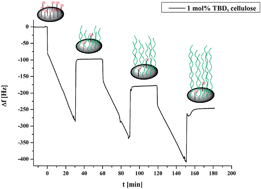Surface-initiated ring-opening polymerization from cellulose model surfaces monitored by a Quartz Crystal Microbalance†
Abstract

* Corresponding authors
a
KTH Royal Institute of Technology, School of Chemical Science and Engineering, Dept. of Fibre and Polymer Technology, TR 56-58, Stockholm, Sweden
E-mail:
annac@kth.se
Fax: +46 8 790 82 83
Tel: +46 8 790 80 27
b KTH Royal Institute of Technology, BiMaC Innovation, Stockholm, Sweden
c KTH Royal Institute of Technology, School of Chemical Science and Engineering, Wallenberg Wood Science Centre, Stockholm, Sweden

 Please wait while we load your content...
Something went wrong. Try again?
Please wait while we load your content...
Something went wrong. Try again?
L. Carlsson, S. Utsel, L. Wågberg, E. Malmström and A. Carlmark, Soft Matter, 2012, 8, 512 DOI: 10.1039/C1SM06121F
To request permission to reproduce material from this article, please go to the Copyright Clearance Center request page.
If you are an author contributing to an RSC publication, you do not need to request permission provided correct acknowledgement is given.
If you are the author of this article, you do not need to request permission to reproduce figures and diagrams provided correct acknowledgement is given. If you want to reproduce the whole article in a third-party publication (excluding your thesis/dissertation for which permission is not required) please go to the Copyright Clearance Center request page.
Read more about how to correctly acknowledge RSC content.
 Fetching data from CrossRef.
Fetching data from CrossRef.
This may take some time to load.
Loading related content
